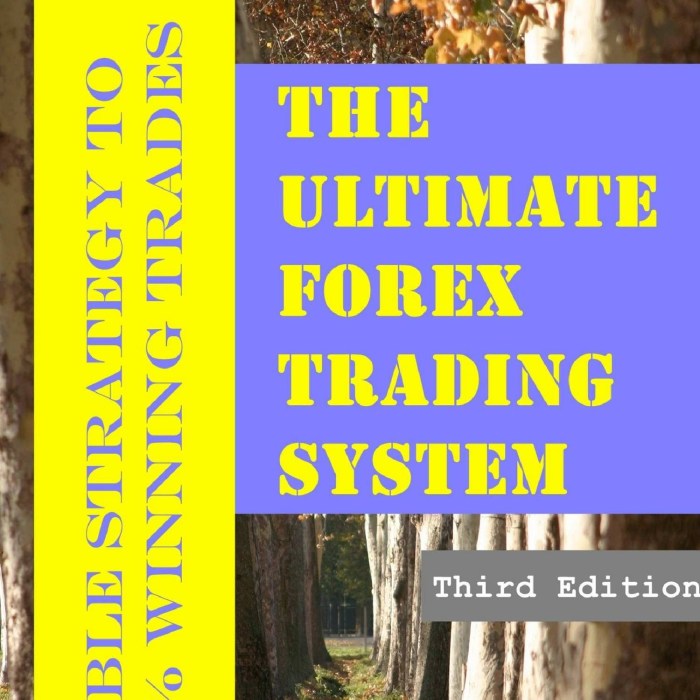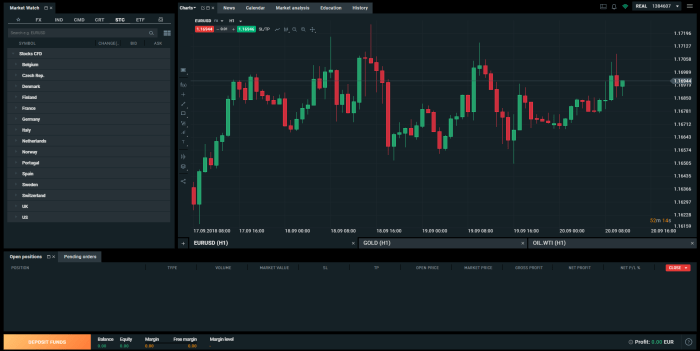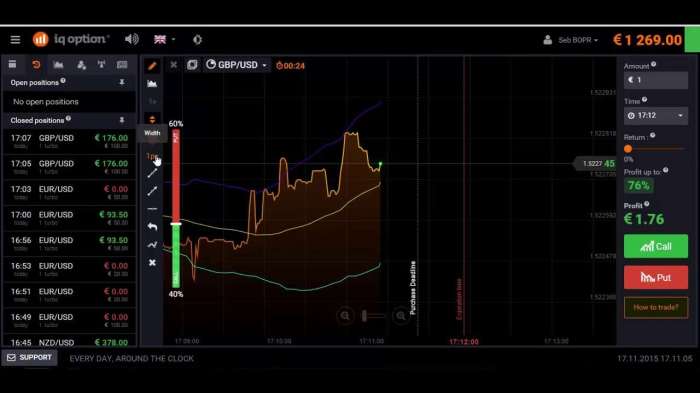
How to Calculate Forex Profits and Losses? Unlocking the secrets of forex trading isn’t just about gut feeling; it’s about numbers. This guide dives deep into the nitty-gritty of calculating your forex wins and losses, demystifying the formulas and strategies behind successful trading. We’ll cover everything from basic profit/loss calculations to the impact of leverage, spreads, and even those pesky overnight fees. Get ready to ditch the guesswork and master your forex financial future.
From understanding currency pairs and pips to navigating the complexities of leverage and margin, we’ll equip you with the knowledge to confidently track your progress and optimize your trading strategies. We’ll break down complex concepts into easily digestible steps, complete with real-world examples, so you can apply what you learn immediately. Whether you’re a seasoned trader looking to refine your calculations or a newbie taking your first steps, this guide is your ultimate roadmap to forex financial clarity.
Understanding Forex Trading Basics
Forex trading, or foreign exchange trading, involves buying and selling currencies in the global market. Understanding the fundamentals is crucial before you even think about calculating profits and losses. This section will break down the key concepts you need to grasp.
Currency Pairs and Their Notation
Forex trading always involves exchanging one currency for another. These are represented as currency pairs, with the notation indicating how much of the first currency (the base currency) you need to buy one unit of the second currency (the quote currency). For example, EUR/USD represents the Euro against the US dollar. A quote of 1.1000 means that one Euro buys 1.10 US dollars. The base currency is always listed first. Other examples include GBP/USD (British Pound/US Dollar), USD/JPY (US Dollar/Japanese Yen), and USD/CHF (US Dollar/Swiss Franc). The notation is standardized and universally understood in the forex market.
The Role of Pips in Calculating Profits and Losses
A pip, or point in percentage, is the smallest price movement in a currency pair. For most pairs, a pip is the fourth decimal place. For example, a move from 1.1000 to 1.1001 is a one-pip increase. However, for currency pairs involving the Japanese Yen (JPY), a pip is the second decimal place. Understanding pips is fundamental because your profit or loss is calculated based on the pip movement multiplied by your position size (the amount of currency you are trading). For instance, a one-pip move on a 10,000 unit position in EUR/USD would represent a $1 profit or loss (depending on the direction of the move).
Types of Forex Orders
Different order types allow you to enter and exit trades according to your specific trading strategy and risk tolerance.
Market Orders: These orders are executed immediately at the best available market price. They are simple and straightforward but may not always be filled at your desired price, especially during periods of high volatility.
Limit Orders: These orders are only executed if the price reaches a specified level. A buy limit order will only be executed if the price drops to your specified level, while a sell limit order will only be executed if the price rises to your specified level. This allows you to buy low and sell high.
Stop Orders: These orders are designed to limit potential losses. A buy stop order is placed above the current market price, and is triggered if the price rises past that level. A sell stop order is placed below the current market price, and is triggered if the price falls past that level. Stop orders can also be used to secure profits by setting a stop-loss order at a profitable level.
Common Currency Pairs and Their Typical Volatility
Volatility refers to how much a currency pair’s price fluctuates. Highly volatile pairs offer the potential for larger profits but also carry greater risk. Less volatile pairs provide more stability but generally offer smaller profit opportunities. This table shows some common pairs and their typical volatility levels (note that volatility is dynamic and can change rapidly).
| Currency Pair | Typical Volatility | Description | Example |
|---|---|---|---|
| EUR/USD | Medium | Relatively stable, high liquidity. | Often used as a benchmark. |
| USD/JPY | Medium-High | Can be affected by interest rate differentials. | Often shows significant daily swings. |
| GBP/USD | Medium-High | Sensitive to economic news from the UK. | Known for periods of significant price movement. |
| USD/CHF | Low-Medium | Often considered a safe haven currency. | Generally exhibits less dramatic price swings. |
Calculating Profit and Loss: How To Calculate Forex Profits And Losses
Understanding how to calculate profits and losses is crucial for successful forex trading. It’s not just about making money; it’s about managing risk and understanding your potential gains and losses before you even enter a trade. This section breaks down the core formula and shows you how to apply it.
The Basic Profit/Loss Formula
The fundamental formula for calculating your profit or loss in forex trading is surprisingly straightforward. It centers around the pip value and the number of pips your trade moves in your favor (profit) or against you (loss). The calculation considers the lot size you’ve traded, which directly impacts the overall monetary value of each pip movement.
Profit/Loss = (Pip Movement * Pip Value) * Lot Size
Lot Size’s Impact on Profit/Loss
Lot size refers to the number of base currency units you’re trading. A standard lot is 100,000 units, a mini lot is 10,000 units, and a micro lot is 1,000 units. The larger the lot size, the greater your potential profit (or loss) for each pip movement. Trading larger lot sizes magnifies both your potential gains and your risk exposure. For example, a 10-pip movement on a standard lot will result in a significantly larger profit than the same movement on a micro lot. Careful consideration of lot size is essential for effective risk management.
Example Calculation: EUR/USD, How to Calculate Forex Profits and Losses
Let’s say you bought 0.1 lots (10,000 units) of EUR/USD at an exchange rate of 1.1000. You later closed your position at 1.1020. This represents a 20-pip movement in your favor (1.1020 – 1.1000 = 0.0020, and since each pip is 0.0001, we have 20 pips).
Let’s assume, for simplicity, a pip value of $10 per 0.1 lot (this can vary depending on your broker and the currency pair). Using the formula:
Profit/Loss = (20 pips * $10/pip) * 0.1 lots = $20
Your profit on this trade would be $20. Had the price moved against you, the result would have been a $20 loss.
Step-by-Step Profit/Loss Calculation
Here’s a step-by-step guide illustrating the calculation, with visual aids described:
1. Determine the Pip Movement: Imagine a simple graph showing the price of EUR/USD. The x-axis represents time, and the y-axis represents the price. Mark your entry point and your exit point on the graph. The difference between these two points represents the pip movement. For example, if your entry was 1.1000 and your exit was 1.1020, the pip movement is 20 pips (upwards).
2. Calculate the Pip Value: This value depends on the currency pair, the lot size, and your broker. Imagine a table showing the pip value for different lot sizes for EUR/USD. For this example, let’s assume the pip value for 0.1 lot is $10.
3. Apply the Formula: Now, imagine a simple calculator displaying the formula: (Pip Movement * Pip Value) * Lot Size. Substitute the values: (20 pips * $10/pip) * 0.1 lots = $20.
4. Interpret the Result: The result ($20) indicates your profit from the trade. A negative result would indicate a loss.
Impact of Leverage and Margin
Forex trading involves significant risk, and understanding leverage and margin is crucial for managing that risk effectively. Leverage amplifies both your potential profits and your potential losses, while margin acts as a security deposit to cover potential losses. Misunderstanding these concepts can lead to substantial financial setbacks.
Leverage allows you to control a larger position in the market than your actual capital would permit. For example, a 1:100 leverage means you can control $100,000 worth of currency with only $1,000 of your own money. This magnification of trading power is a double-edged sword; while it can dramatically increase profits on successful trades, it can equally amplify losses on unsuccessful ones. A small market movement against your position can quickly wipe out your initial investment if you’re using high leverage.
Margin Requirements and Risk
Margin is the amount of money you must deposit in your trading account to open and maintain a leveraged position. It acts as collateral for the broker. If your trade moves against you, and your losses exceed your margin, your broker will issue a margin call, requiring you to deposit more funds to cover the potential losses. Failure to meet a margin call can result in the liquidation of your position, leading to substantial losses. The margin requirement is usually expressed as a percentage of the total trade value. For instance, a 2% margin requirement on a $100,000 trade would necessitate a $2,000 margin deposit.
High Leverage versus Low Leverage Trading
Trading with high leverage offers the potential for significant returns, but it comes with significantly increased risk. Small market movements can lead to substantial losses, and the potential for margin calls is much higher. Conversely, low leverage trading limits potential losses but also reduces the potential for large profits. It’s a more conservative approach, suitable for risk-averse traders. The choice between high and low leverage depends on your trading style, risk tolerance, and experience level. Beginners are strongly advised to start with low leverage to gain experience and develop their trading strategies before gradually increasing leverage.
Leverage Levels and Risk Profiles
The following table illustrates different leverage levels and their corresponding risk profiles. Remember that these are general guidelines, and the actual risk can vary based on market conditions and your trading strategy.
| Leverage Ratio | Risk Profile | Potential Profit | Potential Loss |
|---|---|---|---|
| 1:10 | Low | Low | Low |
| 1:50 | Medium | Medium | Medium |
| 1:100 | High | High | High |
| 1:200 | Very High | Very High | Very High |
Accounting for Spreads and Commissions
Calculating forex profits and losses isn’t just about the price movements; you also need to factor in the often-overlooked costs associated with your trades. These hidden fees, primarily spreads and commissions, can significantly impact your bottom line, sometimes eating into your profits or even turning a potential win into a loss. Let’s dive into how these elements affect your forex trading results.
Forex Spreads: The Bid-Ask Difference
The forex spread represents the difference between the bid price (what you’d get if you sell a currency pair) and the ask price (what you’d pay if you buy). Brokers earn their profit from this spread. It’s a crucial component to consider because it directly impacts your entry and exit prices, subtly influencing your overall profit or loss. A wider spread means a higher cost per trade. For instance, if the EUR/USD bid is 1.1000 and the ask is 1.1002, the spread is 2 pips (points).
Spread’s Influence on Profit/Loss Calculations
Spreads are automatically factored into your trade’s outcome. When you open a position, you enter at the ask price, and when you close, you exit at the bid price. This inherent difference affects your realized profit or loss. Let’s say you bought EUR/USD at 1.1002 (ask) and sold it later at 1.1010 (bid). While the apparent price movement suggests a profit of 8 pips, your actual profit is only 6 pips after accounting for the 2-pip spread. This seemingly small difference can accumulate significantly over numerous trades.
Commissions: Explicit Trading Costs
Unlike spreads, which are implicit costs built into the price, commissions are explicit fees charged by some brokers for executing trades. These commissions can be a fixed amount per trade or a percentage of the trade value. They directly reduce your overall profit. The impact of commissions is straightforward: it’s a direct deduction from your final profit.
Illustrative Examples: Spreads and Commissions in Action
Let’s consider two scenarios to illustrate how spreads and commissions affect profitability.
Scenario 1: A trader buys 10,000 units of EUR/USD at 1.1002 (ask) and sells at 1.1010 (bid) with a 2-pip spread. The profit from price movement is 8 pips, but after accounting for the spread, the net profit is 6 pips. This translates to a profit of 60 USD (6 pips * 10,000 units).
Scenario 2: The same trader executes the same trade, but this time, their broker charges a 5 USD commission per trade. The initial 60 USD profit is now reduced to 55 USD after accounting for the commission. The impact of the commission is clearly visible in reducing the final profit.
Analyzing Profit and Loss Statements
Understanding your forex trading performance goes beyond simply knowing whether you made a profit or loss. A detailed analysis of your profit and loss (P&L) statement is crucial for identifying strengths, weaknesses, and areas for improvement in your trading strategy. This allows you to refine your approach and ultimately boost your profitability.
Your forex broker provides a statement summarizing your trading activity over a specific period. Let’s break down how to decipher this crucial document.
Forex Trading Statement Structure
A typical forex trading statement usually includes your account details, the reporting period, a summary of your trading activity, and a detailed breakdown of your profits and losses. You’ll find information on open and closed trades, commissions, swaps (overnight financing charges), and the net profit or loss for the period. The exact format might vary slightly depending on your broker, but the core elements remain consistent. A well-structured statement allows for a clear view of your trading performance, enabling you to pinpoint successful strategies and identify areas needing attention.
Interpreting Key Metrics
Understanding the key metrics on your statement is paramount. Open trades represent positions you currently hold, while closed trades reflect past transactions that have been settled. Net profit/loss is the ultimate figure – your total profit or loss after considering all transactions, commissions, and swaps. A positive net profit signifies successful trading during the period, while a negative value indicates losses. It’s vital to analyze both the individual trades and the overall net result to gain a complete picture of your performance.
Identifying Areas for Improvement
Analyzing your P&L statement goes beyond simply looking at the bottom line. By examining individual trades, you can identify patterns and trends. For instance, consistently losing trades on specific currency pairs might indicate a need to refine your analysis or risk management for those pairs. Similarly, a high frequency of small profits and large losses might signal a need to adjust your position sizing or stop-loss levels. Regular review and analysis of your P&L statement will allow you to progressively improve your trading strategy and increase your chances of long-term success.
Sample Trading Statement
Let’s illustrate with a hypothetical example. Imagine a statement covering the period of January 1st to January 31st.
Account Holder: Jane Doe
Account Number: 123456789
Reporting Period: January 1st – January 31st
| Trade | Currency Pair | Open Date | Close Date | Units | Entry Price | Exit Price | Profit/Loss | Commission | Swap |
|—|—|—|—|—|—|—|—|—|
| 1 | EUR/USD | Jan 5 | Jan 10 | 10,000 | 1.1000 | 1.1100 | $100 | $2 | $0.50 |
| 2 | GBP/USD | Jan 15 | Jan 20 | 5,000 | 1.2500 | 1.2400 | -$50 | $1 | $0.25 |
| 3 | USD/JPY | Jan 25 | Jan 30 | 15,000 | 110.00 | 111.00 | $150 | $3 | $0.75 |
Total Open Trades: 0
Total Closed Trades: 3
Net Profit/Loss: $200 – $6 – $1.50 = $192.50
This simplified statement demonstrates the key components. A real statement would be more extensive, including details like margin used, leverage applied, and potentially more trades. The crucial aspect is to systematically analyze this data to refine your approach and improve your profitability over time.
Advanced Profit/Loss Scenarios
Forex trading can get significantly more complex than simple buy-low, sell-high scenarios. Understanding how profit and loss are calculated in advanced situations is crucial for consistent success. This section dives into hedging, multiple trades, and the impact of overnight fees.
Hedging Strategies and Their Effect on Profit/Loss
Hedging involves taking offsetting positions to reduce risk. For instance, a trader might buy a currency pair and simultaneously sell a related pair to mitigate potential losses from market fluctuations. The impact on profit/loss depends on the specific strategy and market movements. If both positions move favorably, the profit will be less than if only one position were held; however, if one position loses, the other might offset some or all of the loss. Let’s say a trader buys 1 lot of EUR/USD at 1.1000 and simultaneously sells 1 lot of USD/JPY at 110.00. If EUR/USD rises to 1.1100 and USD/JPY falls to 109.00, the trader would have a profit on the EUR/USD trade and a profit on the USD/JPY trade, although the overall profit might be less than if they’d only traded EUR/USD. Conversely, if EUR/USD falls and USD/JPY rises, the losses on one trade could be partially offset by the profits on the other. Precise profit/loss calculation requires considering the pip values of each currency pair and the lot sizes involved.
Profit/Loss Calculation with Multiple Trades and Currency Pairs
Trading multiple currency pairs simultaneously introduces complexity. Profit/loss is the sum of individual trade profits and losses. It’s crucial to track each trade meticulously, noting the entry and exit prices, lot sizes, and any applicable fees. Consider a trader holding three positions: a long position in GBP/USD, a short position in EUR/USD, and a long position in USD/JPY. The profit or loss on each trade is calculated individually based on the price movement and lot size. The overall profit or loss is the algebraic sum of the individual results. For example, if the GBP/USD trade yields a $100 profit, the EUR/USD trade a $50 loss, and the USD/JPY trade a $75 profit, the total profit would be $125 ($100 – $50 + $75).
Accounting for Overnight Swaps or Rollover Fees
Holding positions overnight often incurs swap fees, also known as rollover fees. These fees reflect the interest rate differential between the two currencies in a pair. Long positions in currencies with higher interest rates generally earn positive swaps, while short positions incur negative swaps. The amount of the swap fee varies depending on the pair, the leverage used, and the size of the position. These fees are automatically added or subtracted from the account balance at the end of each trading day. Accurate profit/loss calculations must include these fees; otherwise, the final result will be inaccurate. For instance, if a trader makes a $200 profit on a trade but incurs a $5 swap fee, their net profit is only $195.
Examples of Complex Trading Scenarios and Their Corresponding Profit/Loss Calculations
Let’s illustrate with a concrete example: A trader opens three trades:
| Trade | Currency Pair | Lot Size | Entry Price | Exit Price | Profit/Loss (per lot) |
|---|---|---|---|---|---|
| 1 | EUR/USD | 1 | 1.1000 | 1.1050 | $50 |
| 2 | GBP/USD | 0.5 | 1.2500 | 1.2450 | -$25 |
| 3 | USD/JPY | 1 | 110.00 | 110.50 | $50 |
Ignoring swaps, the total profit would be $75 ($50 – $25 + $50). However, if overnight swap fees totaled -$10, the final net profit would be $65. This example demonstrates the importance of accounting for all factors when calculating overall profitability. More complex scenarios might involve multiple trades across several days, requiring meticulous record-keeping and calculations. Specialized trading platforms often automate these calculations, but understanding the underlying principles remains crucial.
Concluding Remarks

Mastering the art of calculating forex profits and losses is crucial for consistent success in this dynamic market. By understanding the fundamental formulas, the impact of leverage and spreads, and how to interpret your trading statements, you’ll be empowered to make informed decisions, minimize risks, and maximize your potential returns. So, ditch the guesswork, embrace the numbers, and confidently navigate the exciting world of forex trading! Your financial future awaits.
Helpful Answers
What is a pip in forex trading?
A pip (point in percentage) is the smallest price movement in a currency pair. It’s usually the last decimal place, though some pairs use fractional pips.
How do I account for slippage in my profit/loss calculations?
Slippage, the difference between the expected and executed price, is difficult to predict precisely. However, it’s good practice to factor in a potential slippage buffer when estimating profits.
What are some common mistakes traders make when calculating profits and losses?
Common mistakes include ignoring spreads and commissions, miscalculating lot sizes, and failing to account for leverage’s impact on potential losses.
How often should I review my forex trading statements?
Regularly reviewing your statements – at least weekly or monthly – allows you to track your performance, identify patterns, and adjust your strategies accordingly.
Obtain recommendations related to Forex Trading Hours Explained: When to Trade for Maximum Profit that can assist you today.
Obtain recommendations related to The Best Forex Trading Courses in 2025 that can assist you today.






